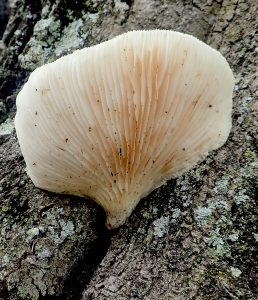
Oysters Mushrooms are often prolific. Photo by Green Deane
Oyster Mushrooms fall into that category of a wild food so good that it’s also cultivated. It is also one of the six to eight fairly mistake-proof mushrooms for folks to hunt for. There are several edible species. As with any mushroom and indeed any wild plant, check with a local expert first.
These tend to be cooler weather fungi. I find them on dead or doomed hardwood trees, usually oak. They’re called Oyster because of their shape not taste. They’re about the size of an oyster shell (which I dug a lot as a young man in the mud flats of Maine.) They also usually have a gilled stem that is off set. It is rare for me to find one or two Oyster Mushrooms. Usually there is a whole tree trunk of them. The exception are occasional solitary species in warm weather growing palm stumps.

If they have a stem it is usually off-set. Photo by Green Deane
Curiously mushrooms are more closely related to humans than plants. They make vitamin D, one reason to eat them. And things that bother us can bother them so if they are healthy there’s probably no bad environmental toxins involved. As for nutrition 100 grams of fresh oyster mushrooms have 33 calories, 3.13 grams of protein, 0.41 grams of fat, 6.09 grams of carbohydrates and 2.3 grams of fiber. There is 1.11 grams of sugar and it is glucose. No vitamin C reported and barely any vitamin A, 2 mcg RAE or 48 IU. Vitamin D, however, is 29 IUs of vitamin D (0.7 mcg of that D2.) The B vitamins are B1 (thiamin) 0.125 mg, B2 (riboflavin) 0.349 mg, B3 (niacin) 4.956 mg, B5 (pantothenic acid) 1.294 mg, B6 (pyridoxine) 0.11 mg, folate 38 mcg, choline 48.7 mg, and Betaine 12.1 mg. The minerals are potassium 420 mg, phosphorus 120 mg, sodium and magnesium 18 mg, calcium 3 mg, iron 1.33 mg, zinc 0.77 mg, copper 0.244 mg, manganese 0.113 mg, and selenium 2.6 mcg.
Oyster Mushroom also have ergothioneine an antioxidant which might decrease inflammation. They also have lovastatin. Pleurotus ostreatus means “sideway oyster” a reference to the general shell shape and the stem or pseudo-stem usually to one side. Two others we see are Pleurotus pulmonarius and Pleurotus populinus. (Lung shape and inhabiting populars.) P. pulmonarius can be seen in warm weather and P. populinus likes populars.)
Green Deane’s Itemized Plant Profile

They like hardwoods, usually oaks. Photo by Green Deane
IDENTIFICATION: Shelf-like clusters, usually numerous, kidney or fan shaped or nearly round mushroom to six inches across, can be greasy when young, pale to buff, edge can be rolled in some, gills run down the short stem or pseudostem or no stem, gills are close. Spore print white to lightly yellow or lilac.
TIME OF YEAR: Late fall to spring (though in Florida some species grow on dead palms in the summer.)
ENVIRONMENT: on logs, living trees or dead standing trunks. Usually hardwood, occasionally conifers. I have seen them on Magnolia virginiana and Sycamores.
METHOD OF PREPARATION: Cooked any way you like. They have a slightly chewy texture, the flavor ranges from mild to nutty to seafood-ish. Very versatile in the kitchen. They have been cultivated for more than a century starting in WWI.

